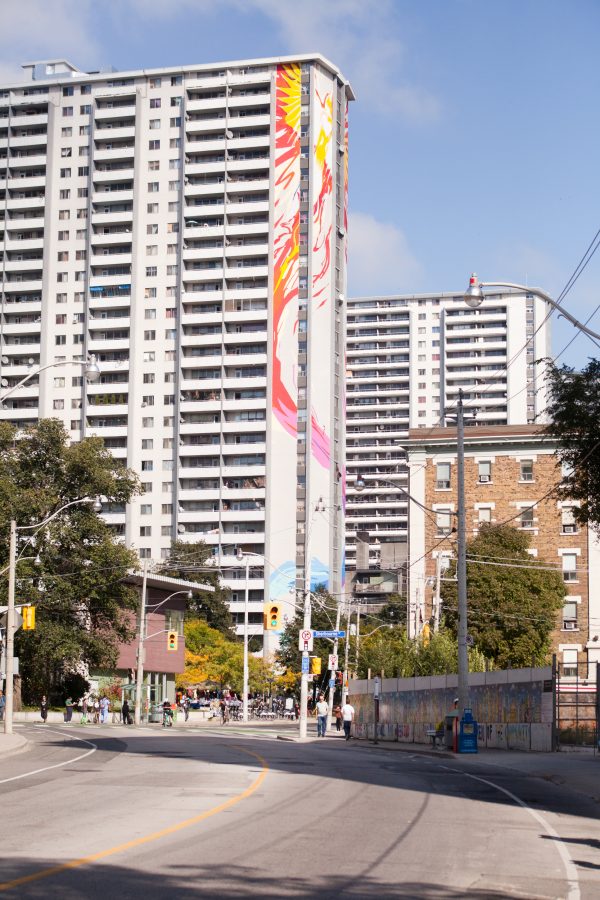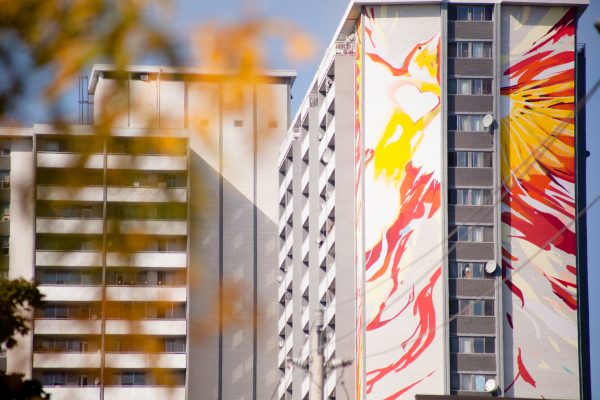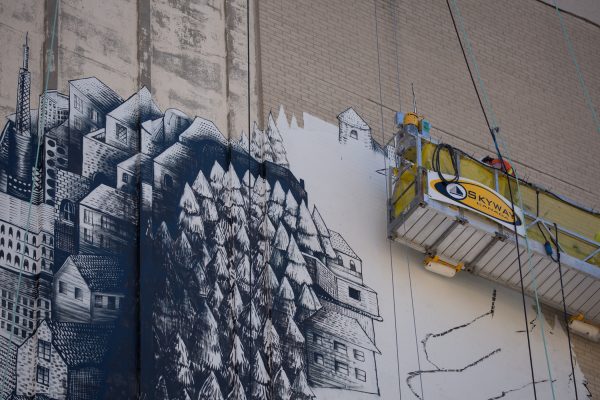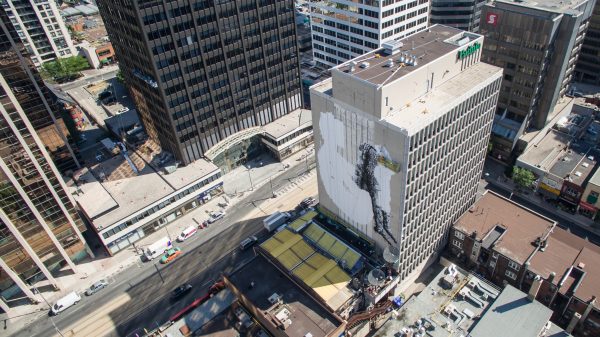Interview by: Ilana Altman
STEPS is an award-winning public arts organization that has been responsible for some of Canada’s most iconic works—including the World’s Tallest Mural, located in downtown Toronto in which they involved thousands of Torontonians. Their social enterprise PATCH is a full-serve art agency, with a unique collaborative focus, engaging landowners and developers, as well as local artists, to transform underutilized spaces into an ongoing curated exhibition.
We spoke with Alexis Kane Speer, the Founding Director of The STEPS, to learn more about the organization’s unique production model and their most recent project, an 8-storey mural at Yonge and St Clair. #PHLEGMPAINTS #YONGESTCLAIR
Ilana Altman: The STEPS Initiative was founded in 2011 in an effort to build local capacity, create opportunities for engagement and better connect communities to their public spaces through art. How did you come to form the organization? Was there much support for social-based practices at that time?
Alexis Kane Speer: Inspired by graduate work that I was doing that focused on the impact of creative play in public spaces, on fostering community social ties and civic engagement, in our early days STEPS was just a personal project. Wanting to step away from my work in academia, and really get a feel for how grassroots public space initiatives were being rolled out in different places, the original intention was to spend six months traveling across Canada connecting with groups who were doing this kind of work, and documenting their lessons learned along the way. In many cases, you may not know what’s happening across your own city, unless you encounter it firsthand, and with so many groups inspired by a shared passion for this kind of work there were missed opportunities to connect with or learn from others groups who were employing similar models out of town.
After connecting with over 100 different projects, it seemed like a disservice not to try to do something with the information that had so generously been shared with me. I was fortunate that the Centre for Social Innovation based here in Toronto was kind enough to incubate STEPS as we found our footing in the sector.
I was blown away by the initiatives we came across, alongside the fact that aside from a handful of projects most didn’t view themselves as what would be deemed “social practice”. Some had an aversion to calling their work a form of “activism”, when they were creatively claiming space for groups who otherwise didn’t have it in their hometowns.
IA: You use the term public space ARTivism to describe your work. Can you tell me more about this philosophy?
AKS: We believe that public spaces, as unmediated sites of interaction between diverse people, are eroding. Art can not only aesthetically transform these spaces, but also serve as a common language with which people can create shared spaces that foster civil society. As such, we endeavour to provide a platform from which to lead initiatives that validate personal experiences; community’s cultures and histories, and concern for social and environmental issues, all while transforming their community’s public spaces.
Public Space ARTivism for us is just a playful way of saying “art as a means of claiming space”, which we view as a form of activism. Our projects are characterized by a high degree of community-engagement. In general, projects develop from a community group coming to us with a space that they feel is unsafe, unwelcoming, or just plain unattractive, and we work with them to identify what might be an appropriate approach for not only the space, but the community members who use it. In some cases this may be permanent, in others it’s temporary activation. While our work has largely been visual-arts based, we have facilitated a number of performative works as well, and a big part of what we do is identify who the appropriate artistic lead might be on a given site.
IA: The Emerging ARTivist Program that supports youth-led projects and promotes critical engagement is one of your most successful endeavours to date. Why is youth engagement so important?
AKS: Not only has the Emerging ARTivist Program been one of our most successful endeavours, it was our first program. It serves as an avenue for the voices of tomorrow’s civic leaders to develop, and probably continues to be our most rewarding program. The Program challenges young people to think critically about the city and their role in making it a more vibrant place. In collaboration with leading interdisciplinary artists, participants tackle the questions of: What is public space, and why is it important? What makes a public space great? How can public spaces contribute to community life? What role can I play in creating a vibrant community?
When the program was initially launched, it was facilitated over longer periods of time with smaller groups of youth in what had been identified as “priority neighbourhoods” around the city. While this approach allowed us to work deeper with engaged youth, in some cases even spurring independent and award-winning youth-led arts collectives, it did limit our reach. As such we’ve instead begun to embed elements of the original program (and thus youth capacity building) in as many STEPS’ projects as possible, so as to touch as many young people as possible.
IA: The World’s Tallest Mural produced in 2013 with Toronto-based artist Sean Martindale is an example of a youth-led initiative. The work transformed the blank façade of a 32-storey modernist social housing building into a soaring space for art. How has this project been received by the community? What impact has it had on the neighbourhood?
AKS: Our youth program has resulted in several permanent art installations, the largest and most well known of which is the World’s Tallest Mural located in Toronto’s St. James Town community. The mural was the culmination of a year’s work with over 50 young people from the area who had been exploring different aspects of their local built environment. The decision to pursue a mural on the building’s facade came from the desire for the otherwise grey built form in the neighbourhood to reflect the vibrancy held within its social fabric.

The design itself was informed by conversations with hundreds of community members and incorporates the motif of a bird soaring up the building, emblematic of a phoenix rising, to counter the negative stereotypes associated with the neighbourhood. The lower sections, which often go un-noticed by people who are not from the area, were painted by young people and reflect themes of diversity, accessibility, local culture, safety and general happiness.
The project’s completion was celebrated with a Culture Days event that attracted several thousand members of the community with a variety of arts and cultural activities, including screen-printing of the phoenix design onto clothing and other fabrics that you still see proudly adorning the community. We received the inaugural national Cultural Days Innovative event award for these festivities.

Since public art is subjective and open to critique inevitably there were a handful of very vocal folks who didn’t like it, but the project was overwhelmingly supported by local residents. The project also attracted attention to the building itself and fostered dialogue on significant infrastructure improvements that were needed in the area. This is not the first time one of our community projects garnered attention and action in response to public realm challenges. In general, we feel like if a project doesn’t foster any dialogue or debate, than we’re probably not pushing ourselves enough.
IA: You have recently completed another ambitious project #StClairMural developed in response to an underutilized site at Yonge & St. Clair. Can you tell me more about the mural and the partnerships put in place to support its creation?
AKS: Ambitious indeed! While not our largest work to date, this project came with its own challenges: from working on what turned out to be a technically difficult surface (requiring a complex equipment setup) to developing a design that was locally relevant with an artist who had not previously visited our city, and convincing new partners who had not previously been involved in public art that engaging a street artist with a unique style was the right approach for an otherwise more conservative area.
Having recently acquired all four corners in Toronto’s midtown Yonge and St. Clair hub and with a very forward-thinking vision for revitalizing the neighbourhood into a 24/7 work-live-play hub, the property owner (Slate Asset Management) realized they were sitting on an asset that differed from those which they’re known for: a giant blank canvas.
Slate reached out to StreetARToronto, a unique partnership program facilitated by the City of Toronto that provides matching funds for public art projects and have financed much of the city’s high calibre street art over the last four years. Drawing on our portfolio of past works, and having developed a strong relationship with StreetARToronto, we were lucky enough to be invited to the table, and asked to produce the work. STEPS managed all aspects of the project, which ranged from identifying an appropriate artist; to facilitating extensive community engagement; fundraising; and, working out all the technical details around ensuring the safe production of the work.
While there were many community stakeholders involved in the project at various stages, we really can’t say enough about what a fabulous site partner we had for this project. Slate was instrumental at every stage of the work’s development. They didn’t have a history of partnering on cultural projects, they really took a risk by embarking on a sizable initiative well outside their wheelhouse because they understand the business case for the role that public art plays in wider place making initiatives, and we feel fortunate that they decided to do so with STEPS.
In terms of the design of the work itself. You will notice that from afar it’s a human figure looking out at the city at large and contemplating that which is in front of them. Most people don’t realize that Yonge and St Clair is one of the highest points of the city, from which you get a 360-degree view of the surrounding area. The work serves as a metaphor for the living, breathing nature of the city. For the British artist Phlegm, the city is a reflection of all those who live there presently, or have done so over time. As you get closer to the work, you’ll notice that it’s comprised of many local landmarks. You’ll see recognizable features like: the CN Tower; the ROM; St. Lawrence Market; the A frame architecture characteristic of the St Clair area; and local businesses. The curvature of the form allows much of the city’s green space and ravines to be illustrated. These are reflections of the insights that were shared with us in response to community outreach. Because the design looks quite different up close and afar it invites dialogue, encouraging viewers to linger, congregate and connect with one another discussing new elements they notice from one visit to the next.

IA: How has working with an international artist changed the process?
AKS: StreetARToronto funds many local projects each year, along with one international project. When we were first approached to produce this work, this site was proposed as the international site for 2016. STEPS has a strong commitment to fostering opportunities for local artists to exhibit in the public realm, therefore, we had never collaborated with an international artist before. The project offered new challenges which excited us, but staying true to our values we wanted to ensure that the work remained locally relevant and incorporated opportunities for local capacity building.
With limitless possibilities of artists from which to shortlist, we gave careful consideration to the area’s past and future character; along with the local built form and the residents who call it home. Initially presenting a dream list of ten artists from across the globe, we were able to narrow it down to Phlegm, a celebrated British illustrator and one of the world’s top street artists, whose work adorns cities across nearly every continent, including a piece on the Royal Opera House. While the decision making process was hard, it ultimately came down to technical skill; the ability to create the work at a height and in strips, as well as an aesthetic which mirrored the sophistication of the area – and in the end all the key partners got on board.
While known as an organization with a strong focus on community engagement, in collaborating with an artist who would only arrive days before production was slated to begin, our leadership became even more critical. As such, we reached out to over 500 community groups, businesses, resident groups, as well as canvassed area workers, residents and business-owners on their favourite things about the area. We hosted a design consultation meeting to ensure the final work authentically represented the community at large.
As part of our commitment to building capacity for emerging local artists to engage in public art, we tend to hire artist assistants for all our community works, and the St. Clair Mural was no different. While Phlegm generally works alone, he welcomed assuming a mentorship role on the mural with local artist Stephanie Bellefleur. Over the course of the work’s production, she received formal technical and safety training, along with mentorship from our visiting artist and was paid for her time supporting him at each stage of the mural’s development.

IA: How has the public art landscape in Toronto changed in the five years that STEPS has been programming?
AKS: The term “public art” encompasses so much, so I don’t know that I can do this question justice. What I can say is that over the five years that we’ve been producing community-engaged arts, we’ve noticed a more supportive environment and acceptance of various aesthetics and approaches, along with the development of funding streams at the local level, specifically geared towards street art. As a result, we’re seeing a lot of really high calibre works being produced, and not just downtown, but in outlying areas that have not historically been recognized as hosting significant cultural landmarks.
There is a bit of an education piece around community-engaged arts, equating it to more than simply finger painting, and that by incorporating local stakeholders one isn’t making a decision to compromise on the final product. As a very small and relatively new charitable public arts organization, we’ve had to work hard to not only develop the skills to produce the work, but also prove to our stakeholders that a grassroots group like ours is capable of realizing large-scale projects. And while that may be the case, unfortunately the work isn’t always valued at the same level as if it were produced by a for-profit contemporary arts company. While progress has been made by our passionate and talented community arts sector, there is still quite a bit of work to be done.
I think Slate’s decision to work with a group like STEPS, is a great example of a private-public partnership that not only has social impact, but also has a strong business case, as part of larger neighbourhood revitalization and investment strategies.
IA: What’s coming up next for STEPS?
AKS: Just approaching the close of our fifth year, we have been doing considerable of soul searching about our next steps (pun intended).
With our work sitting at the intersection of public art, urban planning and civic engagement, we develop our programming with the intention of fostering unlikely conversations and building the capacity for these sectors to work together whenever possible. We are shamelessly attracted to challenges, and as a result we have been pushing the envelope and setting precedence in terms of how our existing and developing built environment can be leveraged for cultural dialogue and community development. We feel responsible to keep pushing ourselves and key players in these sectors in that same vein.
This is demonstrated part through our growing social enterprise arm – PATCH – a full service public arts agency, the proceeds of which provide the only operational funding for our core charitable activities. While we can be hired to produce permanent works on behalf of private landowners, we’ve recently been focusing on providing tailored hoarding art services for land developers, in response to new legislation. We’ve been thrilled with the response that this initiative has received by some of GTA’s largest developers, as it demonstrates an appetite for new models of fostering cultural space in unlikely places, across industries that don’t have a long history of engagement in the arts.
We are always trying to refine our own approaches, and look forward to exploring ways in which our own learnings can benefit the work of others, whether locally or abroad.
Alexis Kane Speer is the Founding Director of The STEPS Initiative, and its affiliated social enterprise – PATCH. With over 10 years of project management experience, leading public arts, urban planning and community engagement initiatives across the public, private and nonprofit sectors, she was awarded a DiverseCity Fellowship by the Greater Toronto CivicAction Alliance in 2011 for her work leading city-building initiatives, and has since been invited to speak at several international conferences. She is currently on the National Congress Committee for Culture Days, and has served on the Advisory Board of the Toronto Arts Council’s Neighbourhood Arts Network, as well as the Adult Committee for the Delisle Youth Services Art Gallery. Other supporting roles she has held, include those with: the City of Buffalo’s Arts Council, Burning Man, Artvoice Weekly and the University of Toronto. She holds a Masters from the Department of Geography and Planning at the University of Toronto, as well as certificates in Community-Based Research, Capacity Building and Teaching English as a Second Language.
Ilana Altman is a curator, designer and editor based in Toronto and founder of The Artful City initiative.
The Artful City is a bi-weekly blog series exploring the evolution of public art and its role in the transformation of Toronto, both the city fabric and the community it houses. For more information about The Artful City visit: www.theartfulcity.org.





